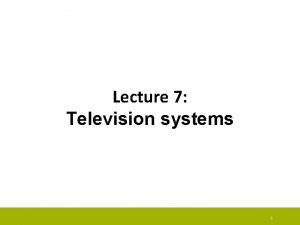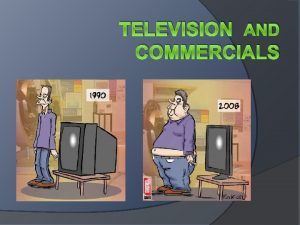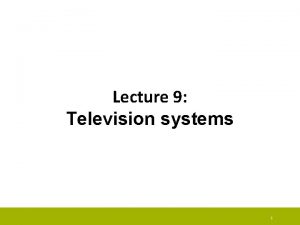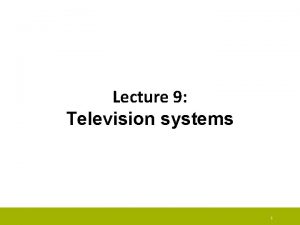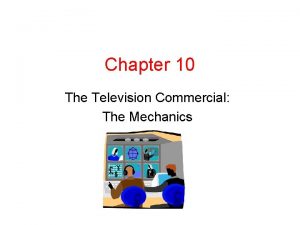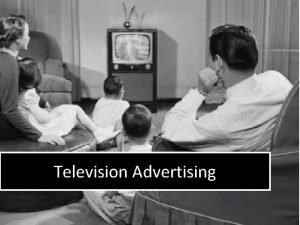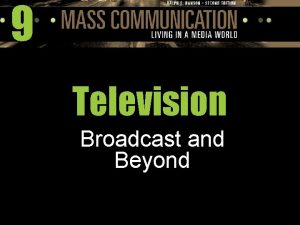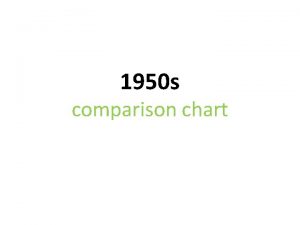Chapter 4 Modern Television Modern Television Early television





























- Slides: 29

Chapter 4 Modern Television

Modern Television Early television had limited options There are many sources of television today ▪ What were the first “ 4” television networks In an effort to expand “affiliates” were developed ▪ What is an affiliate & how do they work What is CATV ▪ Explain why it was developed and how it worked

Today’s Television Industry Broadcast Television Technically all broadcast television stations are local ▪ Signals from a station transmitter travel up to fifty miles ▪ unless picked up by cable, or satellite. TV towers in the Bay Area ▪ Sutro Tower Rising from a hill between Twin Peaks & Mt. Sutro Almost 1600 local stations operate across the United States: ▪ 1200 are commercial and 400 are public (PBS). The 1600 stations are divided between ▪ VHF, or Very High Frequency, channel from 2 through 13. ▪ UHF, or Ultra High Frequency, channels 14 and up.

Growth of Cable TV programming Pay Cable ▪ Commercial Free Cable Channels ▪ HBO started in 1975 ▪ What was it’s first competitor? Who started it? Basic Cable ▪ Satellite delivered programming ▪ Expanded the number of available channels ▪ What was the first Superstation? Others? Narrowcast ▪ Most basic cable channels offered this

Basic Cable Channels in the least expensive program packages ▪ Such as MTV, CNN, etc. supplement ad revenue ▪ By charging cable $. 20 -$. 50/mo ▪ Per subscriber that carries their signal Today specialized basic cable ▪ Includes a number of the earliest basic cable channels

Growth of Cable ▪ What are some examples of Narrowcast stations? Local Origination ▪ Programming usually developed by the cable system Public Access ▪ What are public access channels? Leases access ▪ Where businesses or individuals can buy time ▪ To present there message(s) ▪ What are some current examples of this? Interactive cable ▪ Review in text book

Cable TV’s gold rush Growth between 1975 -1985 ▪ Brought in huge revenue for cable companies Franchising ▪ Regulated by local governments ▪ Led to much of the growth ▪ Companies had to propose bids to get franchise PEG Channels ▪ Cities requested cable companies to set aside channel ▪ For (public, education & government) access

Competition for franchises intensified ▪ Takeovers & consolidation occurred MSO’s (Multiple system operators) ▪ Bought small operations ▪ MSO’s merged with major companies Other participants ▪ Advertisers ▪ Unions/Guilds ▪ Equipment manufacturers

The Cable Industry Today’s cable industry Almost exclusively run by (MSO’s) ▪ Companies that own several local cable providers ▪ In different areas of the country. ▪ MSO’s generally owned by giant corporations ▪ Time-Warner, Comcast, etc. Most cities require MSO’s to have access channels ▪ Open to the public on a first come, first served basis.

Beginnings of Satellite TV Early satellites ▪ Had complicated technology ▪ Improvement by 1979 led to FCC license ruling ▪ No license for TVRO (reception only satellite) DBS ▪ Direct broadcast satellite (what we see today) ▪ Approved in 1982 ▪ All interested parties failed to operate by 1985 Backyard Satellites ▪ Resulted from no license rule ▪ Led to signal scrambling in 1984 ▪ (Why would they want to scramble the signal)

Beginnings of Satellite TV Satellites were a big part of cable TV success. ▪ How can this be? In the 70’s satellites became geostationary ▪ Parked miles above one section of the earth’s surface. Direct Broadcast Satellite (DBS) systems ▪ Deliver television programming to individual homes. By 2007 satellite companies ▪ Claimed subscribers in almost 25% of television homes ▪ Making DBS a serious competitor with cable.

Home Video Tape recorders ▪ Started big & expensive ▪ Introduced to TV stations in 1956 First home Videocassette recorder (VCR) ▪ Sony Betamax (1975) ▪ Cost $1300 (had to be bought with $1000 TV) $2300 total to get one ▪ Competition Drove prices down ▪ Video Home System (VHS) from JVC

Home Video Hollywood was convinced The use of videocassette recorders (VCRs) ▪ Would ruin them Disney and other channels Fought legal battles to stop the sale of home VCRs 1983 Supreme court ruled In Sony Betamax case Video recording for private use ▪ Did not infringe copyright.

Broadcast TV in the 80’s Competition from cable ▪ Split audiences ▪ Reduced ad profits Networks were subject to mergers/takeovers ▪ Capital cities bought ABC in 1985 Sold it to Disney 1 oyrs later ▪ GE bought NBC (which later merged with Universal) ▪ CBS merged with Viacom in 1999 ▪ Rupert Murdoch started Fox network 20 th century Fox 6 metromedia stations

Telecom act of 1996 Required new television sets To contain V-chips ▪ Electronic device used to recognize and block programs ▪ With particular parental advisory rating Removed restrictions On many communications industries ▪ Allowing cable TV ▪ Long distance & local phone companies ▪ Information services & Internet service providers ▪ To merge at will

Telephone Company Entry AT&T operated as a monopoly Until 1980 ▪ Justice department broke up the company ▪ 22 local phone companies became ▪ 7 (RBOC’s) regional Bell operating companies Competition brought about ▪ POTS & PANS (pg 107) ▪ What is that?

Telephone Company Entry Telecom Act Led to Phone/Cable mergers AT&T/TCI 1998 ▪ Idea to provided phone, cable and internet ▪ The idea failed Deregulation of 1996 telecom act Allowed Baby Bells (RBOC’s) ▪ To merge back together ▪ Some merged back with AT&T ▪ Others became Verizon Began offering all 3 services – cable did the same to compete

DVD’s Digital video discs (DVDs) Reached the market in 1996 ▪ Hollywood had initial concerns of DVD’s ▪ Because they were so easily copied Embraced heavily by consumers ▪ Stand alone & computer players ▪ Led to Hollywood acceptance Netflix & Blockbuster adapt to DVD’s ▪ Eventually offer online video ▪ VHS fades

Ti. Vo – Brand name of DVR Digital video recorders (DVRs), ▪ Specialized computers with oversized hard discs ▪ Video signals are saved for later playback ▪ Introduced in 1999. ▪ Allowed time shifting of programs Technology was easy to duplicate ▪ Service providers created their own DVR’s

Programming Changes Modern Era of TV ▪ Brought new programming Reality TV ▪ Became more popular in 2000 ▪ From CBS broadcast of Survivor Game Shows ▪ New game shows or revived game shows ▪ Gained popularity over last decade ▪ What are some current popular reality & game shows

Programming Changes Other types of programming Home Shopping ▪ Allowing people to shop from home Infomercials ▪ Paid programs for products/services Old Genres ▪ Sitcoms, Drama Pay-per-view Video on demand

Programming Television networks & program suppliers Experimenting with ways to offer programming ▪ Downloadable to ▪ Computers, phones & 0 ther digital media. Experts believe video on demand (VOD) Through downloads will be the wave of the future. The cultural effects of the VCR were many ▪ Time shifting, Zapping

Programming Program Providers Networks provide programming to affiliates for large part of day. ▪ Program syndication is selling programs directly to ▪ Stations, cable channels, and online venues, not to the networks. Off-network programs ▪ Earlier on a network & need 100 episodes before being offered in syndication ▪ strip programming-showing a program in the same time slot 5 days a week. “Jeopardy” & “Oprah” are profitable in original syndication, ▪ Which is sale of new programs that were not previously on a network.

Digital TV & HDTV What is the difference between Digital TV & HDTV? Why did people need converter boxes?

Digital and HDTV Broadcast TV networks compete with newer technologies, ▪ Including cable, satellite, on-demand video, video games, and Internet. The broadcast television industry ▪ Switched to digital, high-def television (HDTV) ▪ HDTV can be analog or digital ▪ Digital TV can be standard or high def Digital TV ▪ Signal allows for secondary channels ▪ In addition to Primary Channel ▪ 4 -1, 4 -2, 4 -4, etc What is 4 DTV

Controversies To reach the greatest possible audience ▪ Most TV programs designed to make limited intellectual and aesthetic demands on viewers ▪ Critics are concerned that the quality of programming damages viewers intellectually and emotionally. Most critics agree that TV entertainment is too violent What do you thing about this? ▪ Particularly when the violence goes unpunished or when a program ignores the real life consequences of violent acts. TV producers counter that pleasing the critics ▪ Would severely impede storytelling.

Controversies Research into TV indicates exposure to televised material ▪ Increases the acceptance of ethnic, racial, and sexual stereotypes. Producers say stereotyping is important in because ▪ It allows writers to establish characters quickly and get on with the plot. Critics agree that popular programming such as ▪ “Will and Grace” and “Queer Eye for the Straight Guy” ▪ Have increased tolerance toward gays in the general public. The FCC requires stations to air three hours of educational programming per week ▪ But critics insist that this is not enough.

Controversies Compulsive television viewers ▪ College students watch twice as much TV as other students. Critics say too much time in front of the TV ▪ Keeps viewers from productively dealing with problems. Defenders of television insist that TV is no more addicting than any other form of pleasurable activity. Do you think Television is addictive?

For Wednesday With partner(s) you will develop a television network To place on broadcast, cable, online Things to consider ▪ Programming ▪ Target Audience ▪ How will you reach them ▪ How will you generate revenue ▪ Will it be a pay network (Pay Cable)
 Early cpr and early defibrillation can: *
Early cpr and early defibrillation can: * Early modern period dates
Early modern period dates British literature periods
British literature periods Early modern english syntax
Early modern english syntax Early modern english
Early modern english Archaic pronouns
Archaic pronouns Pre classical school of criminology
Pre classical school of criminology Early modern english period
Early modern english period Early modern english
Early modern english Types of early childhood programs activity a chapter 2
Types of early childhood programs activity a chapter 2 Chapter 9 lesson 1 ancient india
Chapter 9 lesson 1 ancient india Chapter 7 early childhood ages 3 through 5
Chapter 7 early childhood ages 3 through 5 Ancient rome and early christianity
Ancient rome and early christianity The federalist era lesson 2 early challenges
The federalist era lesson 2 early challenges Early childhood is __________ for language learning
Early childhood is __________ for language learning Chapter 11 section 1 early civilizations of africa
Chapter 11 section 1 early civilizations of africa Chapter 14 test form a pre columbian america answers
Chapter 14 test form a pre columbian america answers Political developments in the early republic
Political developments in the early republic Chapter 1 learning about children
Chapter 1 learning about children Chapter 4 oklahoma in early america
Chapter 4 oklahoma in early america Early humans and the agricultural revolution
Early humans and the agricultural revolution Chapter 1 section 1
Chapter 1 section 1 River valley civilizations def
River valley civilizations def Chapter 1 section 3 early british colonies
Chapter 1 section 3 early british colonies Chapter 1 section 3 early british colonies
Chapter 1 section 3 early british colonies Chapter 4 from territory to early statehood vocabulary
Chapter 4 from territory to early statehood vocabulary Chapter 2 early river valley civilizations
Chapter 2 early river valley civilizations Ancient rome and early christianity chapter 6
Ancient rome and early christianity chapter 6 Origin of modern astronomy
Origin of modern astronomy Chemistry chapter 9 stoichiometry
Chemistry chapter 9 stoichiometry
































